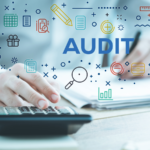Audit evidence refers to the information and supporting documentation obtained by auditors during the course of an audit. It includes the records, transactions, statements, and other relevant data that provide the basis for the auditor’s conclusions and opinions regarding the accuracy and reliability of the financial statements and other information being audited. Audit evidence is used to assess the compliance with applicable laws and regulations, evaluate internal controls, detect fraud or errors, and provide reasonable assurance that the financial statements are free from material misstatements. It encompasses a wide range of sources, such as financial records, contracts, invoices, bank statements, confirmations from third parties, physical inspections, inquiries with management and staff, and analytical procedures. The sufficiency, relevance, and appropriateness of audit evidence are important considerations to ensure the audit is conducted effectively and in accordance with auditing standards. In the next few posts, we will see some more details types of audit evidence, nature and characteristics of audit evidence, and procedures to gather and evaluate audit evidence.
Audit evidence plays a crucial role in the audit process as it provides the foundation for auditors to form their opinions and conclusions on the financial statements and other information being audited. The importance of audit evidence can be summarized in the following key points:
Substantiating Financial Information: Audit evidence serves as the substantiation for the financial information presented in the company’s records and statements. It provides the necessary support to ensure the accuracy and reliability of the reported numbers, ensuring that stakeholders can make informed decisions based on trustworthy information.
Assessing Compliance and Internal Controls: Audit evidence is vital in assessing the compliance of financial statements with accounting standards, laws, and regulations. It helps auditors evaluate the effectiveness of internal controls and detect any potential errors, irregularities, or fraud.
Enhancing Auditor’s Professional Judgment: Audit evidence helps auditors exercise professional judgment and make informed decisions throughout the audit process. It provides a basis for evaluating the reasonableness of accounting estimates, assessing the materiality of misstatements, and forming an opinion on the financial statements.
Providing Audit Trail: Audit evidence creates an audit trail that allows for the tracing and verification of transactions and events. This trail ensures the reliability and integrity of the audit findings and supports the transparency and accountability of the audited entity.
Satisfying Audit Standards and Regulations: Audit evidence is essential to meet the requirements and standards set by auditing bodies and regulatory authorities. It helps auditors demonstrate that they have conducted the audit in accordance with applicable auditing standards, providing assurance to stakeholders and regulatory bodies.
The primary objectives of gathering it are to obtain sufficient, appropriate, and reliable information to support the auditor’s opinion on the financial statements. The key objectives can be summarized as follows:
Assessing Financial Statement Reliability: The main objective of gathering it is to assess the reliability of the financial statements. This involves verifying the accuracy, completeness, and validity of the financial information presented in the statements, ensuring they are free from material misstatements.
Evaluating Compliance: it is gathered to evaluate the entity’s compliance with applicable laws, regulations, and accounting standards. This includes assessing whether the financial statements have been prepared in accordance with the relevant reporting framework and whether the entity has complied with legal and regulatory requirements.
Detecting Errors and Fraud: Another objective of gathering audit evidence is to detect any errors, irregularities, or fraudulent activities. By examining various sources of evidence, auditors can identify instances of misstatements, intentional or unintentional, and assess the adequacy and effectiveness of internal controls in preventing and detecting fraud.
Assessing Internal Controls: it is used to evaluate the design and effectiveness of internal controls within the entity. It allows auditors to determine the extent to which the internal controls are properly designed, implemented, and functioning to mitigate the risk of material misstatements in the financial statements.
Providing Basis for Audit Opinion: The ultimate objective of gathering audit evidence is to provide a basis for the auditor’s opinion on the financial statements. By obtaining sufficient, appropriate, and reliable evidence, auditors can form a professional judgment and express an opinion on whether the financial statements present a true and fair view of the entity’s financial position, results of operations, and cash flows.
In summary, it is of utmost importance in the audit process as it provides the necessary support, substantiation, and assurance to auditors, stakeholders, and regulatory bodies. It ensures the reliability of financial information, assesses compliance, enhances auditor judgment, provides an audit trail, and meets the required standards and regulations.




